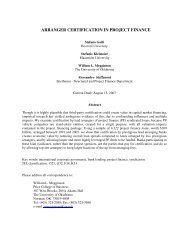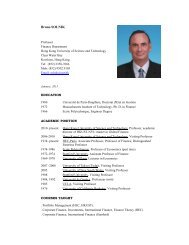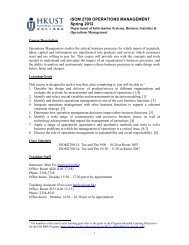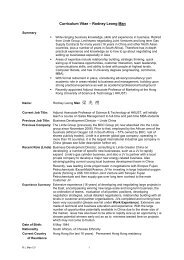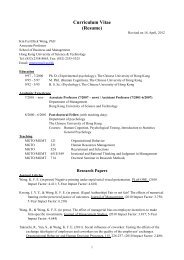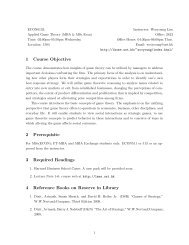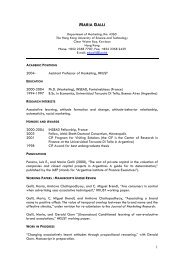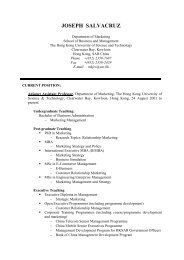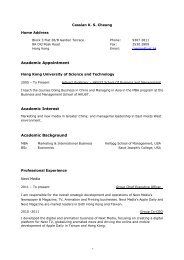Download
Download
Download
You also want an ePaper? Increase the reach of your titles
YUMPU automatically turns print PDFs into web optimized ePapers that Google loves.
The Role of Expectation Formation In a Real<br />
Business Cycle Model<br />
Jang-Ok Cho 1<br />
Revised: May, 2003<br />
1 Economics Department, Hong Kong University of Science and Technology,<br />
Clear Water Bay, Kowloon, Hong Kong, and Research Center on Enployment and<br />
Economic Fluctuations, University of Quebec at Montreal, Montreal, Canada.<br />
(email): jcho@ust.hk. Comments from David Cook, Jeremy Greenwood, Per<br />
Krusell, Francis Lui, Alan Stockman and the seminar participants in the Þrst<br />
Rochester Macro Group Conference and at Hong Kong University of Science and<br />
Technology are gratefully acknowledged. Usual disclaimer applies.
Abstract<br />
This paper looks into the business cycle and welfare implications of adaptive<br />
expectations in a real business cycle model with money. The result shows<br />
that the impulse responses of macroeconomic variables depends on the way<br />
how expectations are formed. Especially the peak responses of the variables<br />
like consumption, capital stock and labor productivity and the persistence<br />
of the responses are affected by the extent of adaptiveness of expectations.<br />
However, adaptive expectations do not have large welfare cost. Hence if there<br />
are small deliberation and/or information costs associated with unboundedly<br />
rational expectations, adaptive expectations can be a rational choice.
1. Introduction<br />
Since the seminal contribution by Muth (1961) and then by Lucas (1972,<br />
1973), rational expectations have been a key building block in modern economic<br />
research. As John Muth (1961) noted in his paper, rational expectations<br />
hypothesize that expectations should be the same as the predictions of<br />
relevant economic theory, which means that rational expectations cannot be<br />
deÞned properly before the underlying theory is laid out.<br />
However, many authors have recently raised questions on the unbounded<br />
rationality of economic agents in economic models (see Conlisk (1996) and<br />
Sargent (1993) for surveys). Especially, survey data on expectations of inßation<br />
and other variables are used to test the implications of rational expectations<br />
hypothesis, namely (1) expectations are required to be unbiased,<br />
(2) available information has to be used efficiently, and (3) any errors in<br />
expectations should be orthogonal to the known information set. Holden,<br />
Peel and Thompson (1985) used many survey data sets including Livingston<br />
survey, the Survey of Consumer Finances by the Survey Research Center,<br />
University of Michigan, Carson and Parkin (1975) series obtained from the<br />
UK Gallup Poll, data from survey conducted by the Institute of Applied Economic<br />
and Social Research, University of Melbourne, etc. and found that the<br />
data including inßation, wage, interest rate and other variables commonly reject<br />
the unbiasedness, efficiency and/or orthogonality predictions of rational<br />
expectations 1 .<br />
Frenkel and Froot ( 1987) made use of exchange rate expectations survey<br />
polled by American Express Corporation, the Economist Financial Report,<br />
and Money Market Services, Inc. to test various hypotheses regarding exchange<br />
rate ßuctuations. They found that the survey data reject the rational<br />
expectations hypothesis. Ito (1990) used the survey data collected<br />
by the Japan Center for International Finance in Tokyo to Þnd that many<br />
individuals’ forecasts violate the rational expectations hypothesis. SharÞr,<br />
Diamond and Tversky (1997) utilized a survey data to see if economic agents<br />
have money illusion and they found that they have indeed. Data from recent<br />
experimental asset markets favor adaptive over rational expectations<br />
(Smith, Suchanek and Williams (1998), Plott and Sunder (1988), Marimon<br />
1 See also Lovell (1985) for a survey. He and other authors used survey data sets like the<br />
Manufacturers’ Inventory and Sales Expectations Survey conducted by the Department<br />
of Commerce from late 1959 through 1976. As Holden et al., he also concluded that the<br />
rational expectations hypothesis is rejected by the survey data.<br />
1
and Sunder (1993)). However, the experimenters found that experienced<br />
subjects move toward rational expectations. The evidence also suggests that<br />
expectations may not be rational, depending on experience, difficulty of the<br />
forecasting task etc.<br />
Until Lucas popularized the hypothesis, most empirical economists had<br />
modelled expectations as adaptive and the most widely used adaptive form<br />
of expectations was Koyck transformation, which uses distributed lags (see<br />
Koyck (1954) and Lucas and Rapping (1969)). Recently, Baak (1997) and<br />
Nerlove and Fonari (1998) showed that adaptive expectations explain better<br />
the ßuctuations in U.S. beef cattle supply. However, according to this<br />
form of expectations, the expectations on a variable depend only on the past<br />
realized values of the variable and thus this form of expectations has systematic<br />
expectational error. For example, suppose the monetary authority<br />
announces that it will increase the rate of money growth. Then it will affect<br />
the expectations immediately in the case of rational expectations but not<br />
have any effect on the expectations in the period of announcement in the<br />
case of adaptive expectations.<br />
Becauseadaptiveexpectationsinvolvesystematicerror,welfarelossis<br />
associated with them. This paper addresses this question in a real business<br />
cycle model with money. First, we ask how large welfare cost is associated<br />
with adaptive expectations. This question is potentially important since if<br />
the welfare cost is not large, economic agent may easily deviate from rational<br />
expectations in the presence of costs of information gathering, deliberation<br />
etc. Second, we ask how adaptive expectations affect the characteristics of<br />
business cycles. We compare the impulse responses in a model with adaptive<br />
expectations to those in a model with rational expectations. The result<br />
shows that the welfare costs of adaptive expectations are so small that deviating<br />
from rational expectations may be a rational choice in the presence<br />
of some costs of gathering information and/or of deliberating economic decisions.<br />
However, the business cycle characteristics depends critically on the<br />
way they form expectations. Especially the timing of peak response of some<br />
variables like consumption, capital stock and labor productivity are quite different<br />
in models with adaptive expectations than in the model with rational<br />
expectations. In addition, the persistence of impulse responses is affected by<br />
the degree of adaptiveness of expectations. In general, the more adaptive the<br />
expectations are, the more persistent are the impulse responses.<br />
In the next section of the paper, we describe the economic environment.<br />
2
The third section deÞnes the equilibrium, discusses the calibration of parameters<br />
and describes the solution technique. The fourth section presents the<br />
results from the simulation. Finally, section 5 concludes<br />
2. The Economy<br />
We consider an environment populated by a continuum of identical agents<br />
or households. Each agent is endowed with one unit of time per period, initial<br />
capital stock k 0 and initial money holding m 0 2 . Agentsinthiseconomy<br />
hold money because real money balances reduce the costs of consumption<br />
transaction, which will be made clear soon. Each agent maximizes his lifetime<br />
utility which assumed to be additively time separable:<br />
U = e E 0<br />
( ∞ X<br />
·<br />
β t<br />
t=0<br />
1<br />
1 − σ · ³<br />
c ν t lt<br />
1−ν<br />
´1−σ¸)<br />
, (1)<br />
where c t is the consumption and l t is the leisure in period t. Hence the hours<br />
of work can be obtained as n t =1−l t . β is the utility discounting factor, and<br />
ν and σ are preference parameters. Agents form expectations according to<br />
adaptive expectations formula, which will be clariÞed later, and we will let<br />
fE t denote the adaptive expectations conditional on the information available<br />
in period t 3 .<br />
Agents maximize (1) subject to the following sequence of budget constraints:<br />
P t (c t + i t + ψ t )+m t+1 ≤ W t n t + R t k t + m t + Γ t . (2)<br />
The variables in the lefthand side of (2)are the household expenditures and<br />
those on the right-hand side are the available funds. i t is the investments in<br />
period t and hence capital stock, k t , follows the following law of motion 4 :<br />
k t+1 =(1− δ)k t + i t , (3)<br />
where δ is the rate of capital depreciation. ψ t is the cost of transactions,<br />
which will be speciÞed later and m t+1 is the money holdings in period t,<br />
2 We use the convention throughout that lower case letters denote individual choices<br />
and capital letters denote their aggregate per-capita counterparts.<br />
3 Note, however, that adaptive expectations do not utilize the available information<br />
fully.<br />
4 Aggregate per capita capital stock K t follows an analogous law of motion.<br />
3
which will be carried over to the period t +1. W t and R t are the nominal<br />
wage rate and the nominal rental rate of capital, respectively, and Γ t is the<br />
lump sum transfer of money in period t from the government, which can be<br />
written as:<br />
Γ t =(g t − 1)M t , (4)<br />
where g t is the gross growth rate of money between periods t−1 andt. That<br />
is, the newly created money in period t is transfered to the private agents in<br />
a lump sum way. We assume that the rate of money growth follows AR(1)<br />
process.<br />
ln(g t )=η ln(g t−1 )+ω t , where ω t ∼ i.i.d. N[(1 − η)ln(g),σ 2 ω] (5)<br />
Here g isthemeanrateofmoneygrowth,whichisassumedtobeÞxed, and<br />
σ 2 ω is the variance of the money growth innovation.<br />
We assume that consumption transactions incur the following costs.<br />
µ <br />
ψ t = φ · c γ mt + Γ 1−γ<br />
t<br />
t<br />
, (6)<br />
P t<br />
where φ>0andγ>1. This speciÞcation of the transaction costs includes<br />
the cash in advance constraint as a special case 5 .<br />
The Þrm in the economy produces output, Y t , using the Cobb-Douglas<br />
production technology:<br />
Y t = A t K θ t N 1−θ<br />
t , 0 ≤ θ ≤ 1, (7)<br />
where θ is the share of capital in the production, A t is a productivity shock,<br />
K t is the per-capita capital stock and N t is the per-capita hours of work. It<br />
is assumed that the technology shock follows an AR(1) process :<br />
ln(A t )=ρ ln(A t−1 )+ε t , where ε t ∼ i.i.d N(0,σ 2 ε), (8)<br />
where σε 2 is the variance of the technology shock innovation.<br />
The Þrm solves a series of maximization problems in each period:<br />
h<br />
Pt · ³<br />
´ i<br />
A t Kt θ Nt<br />
1−θ − Wt N t − R t K t . (9)<br />
Max<br />
{N t,K t}<br />
5 If γ →∞, (6) reduces to the cash-in-advance constraint.<br />
4
The proÞt maximization maximization by the Þrm implies the following conditions<br />
equating the marginal product of an input to its real price:<br />
W t /P t =(1− θ)A t [K t /N t ] θ (10)<br />
R t /P t = θA t [K t /N t ] θ−1 . (11)<br />
Note here that the Þrms’ problem is basically static.<br />
Now we elaborate the way the agents form their expectations. Until the<br />
rational expectations were introduced by Lucas (1972, 1973), the most popular<br />
expectations formation was Koyck transformation (see Lucas and Rapping<br />
(1969) for example). That is, given the actual law of motion for money<br />
growth and technology shock, we assume that agents form their expectations<br />
using the Koyck transformation as follows.<br />
∼<br />
⎡ ⎤ 1<br />
E t (A t+1 ) A<br />
∼ = ⎣ t<br />
⎦α<br />
∼<br />
(12)<br />
E t−1 (A t ) E t−1 (A t )<br />
∼<br />
⎡ ⎤ 1<br />
E t (g t+1 ) g<br />
∼ = ⎣ t<br />
⎦α<br />
∼<br />
(13)<br />
E t−1 (g t ) E t−1 (g t )<br />
Taking logarithm of these expectations formula, we can have the followings 6 .<br />
µ ∼Et<br />
µ ∼Et−1<br />
·<br />
µ ∼Et−1<br />
¸<br />
ln (A t+1 ) − ln (A t ) = α 1 ln(A t ) − ln (A t )<br />
(14)<br />
6 Using repeated substitution, we can have the expectations as the functions of the<br />
realizations of the shocks from the inÞnite past to the current period.<br />
ln(A e t)=α 1<br />
ln(g e t )=α 2<br />
∞<br />
X<br />
j=1<br />
∞<br />
X<br />
j=1<br />
(1 − α 1 ) j · ln(A t−j )<br />
(1 − α 2 ) j · ln(g t−j )<br />
5
µ ∼Et<br />
µ ∼Et−1<br />
·<br />
µ ∼Et−1<br />
¸<br />
ln (g t+1 ) − ln (g t ) = α 2 ln(g t ) − ln (g t )<br />
(15)<br />
To simplify the notation, we let Xt<br />
e = E ∼ t−1 (X t ) for any variable X t . Then<br />
we can rearrange the equations as follows.<br />
ln(A e t+1) =α 1 ln(A t )+(1− α 1 )ln(A e t) (16)<br />
ln(g e t+1) =α 2 ln(g t )+(1− α 2 )ln(g e t ) (17)<br />
Here we beg the question of why they form expectations in this way and we<br />
assume that the initial expectations are given as A e 0 and g e 0. They probably<br />
form the expectations in this way due to the fact that there are some psychological,<br />
deliberation and/or information costs. The sole reason to model<br />
expectations in this way is to see how much welfare gain rational expectations<br />
may have and then to look into the dependence of the characteristics<br />
of business cycle ßuctuations on the way that they form expectations 7 .<br />
To make the problem stationary, we use the following changes of variables<br />
by dividing nominal quantities by aggregate stock of money M t+1 .Thatis,<br />
we deÞne the following.<br />
bP t =<br />
P t<br />
M t+1<br />
, c W t =<br />
W t<br />
M t+1<br />
, b R t =<br />
R t<br />
M t+1<br />
Using these changes of variables, we can rewrite (2) and (6) as follows.<br />
c t + i t + ψ t + m t+1 ≤<br />
à c W t<br />
ψ t = φ · c γ t ·<br />
!<br />
n t +<br />
bP t<br />
à b R t<br />
!<br />
k t + cm t +(g t − 1)<br />
bP t g b (18)<br />
t P t<br />
Ã<br />
cmt + g t − 1<br />
g t P t<br />
! 1−γ<br />
(19)<br />
Note also that (10) and (11) can be rewritten as follows.<br />
cW t<br />
=(1− θ)A t [K t /N t ]<br />
bP θ (20)<br />
t<br />
7 In addition, it is acknowledged that there can be numerous ways of expectation formation<br />
which are not rational. However, since the Koyck transformation has been the<br />
most popular econometric formulation in the literature, we use it in the text.<br />
6
R t<br />
bP t<br />
=(1− θ)A t [K t /N t ] θ−1 (21)<br />
Once the equilibrium is obtained, we can recover the variables without hat<br />
through reverse changes of variables. Aggregating (18) and (19) and using<br />
(20) and (21), we can have the following resource constraint.<br />
C t + I t + Ψ t = A t K θ t N 1−θ<br />
t (22)<br />
Ψ t = φ · C γ t ·<br />
Ã<br />
1 b P t<br />
! 1−γ<br />
(23)<br />
(22) is the per capita resource constraint, which may be considered to be the<br />
market clearing condition in the goods market, and (23) is the per capita<br />
costs of consumption transactions.<br />
3. Equilibrium, Calibration and Simulation<br />
ThestateoftheeconomycanbedeÞned as follows.<br />
s t =(1, ln(A t ), ln(A e t), ln(g t ), ln(g e t ).k t ,K t , cm t ) 0 , (24)<br />
Let V (s t ) denote the value function in period t. Then the agent’s lifetime<br />
utility maximization problem can be expressed using Bellman equation as<br />
follows:<br />
V (s t ) = max n 1<br />
1−σ [cν t (1 − n t ) 1−ν ] 1−σ + βE e t [V (s t+1 )] o<br />
(25)<br />
s.t. (18), (3), (4), (5), (16), (17)<br />
The problem is standard except that the expectations are formed in an adaptive<br />
way.<br />
3.1 Equilibrium<br />
The equilibrium in the economy can be deÞned using the Bellman equation<br />
(25) and the Þrm’s proÞt maximization problem (9).<br />
DeÞnition: An equilibrium is a pair of allocations:<br />
{c t ,n t ,i t , cm t+1 ,k t ,ψ t ,Y t ,C t ,N t ,K t , Ψ t } ∞ t=0 ,<br />
7
prices n P b t , W c t , R b o ∞<br />
t and value function V (s t) such that, given the initial<br />
t=0<br />
values k 0 ,m 0 ,A 0 ,A e 0,g 0 and g0,<br />
e<br />
(i) {c t ,n t ,i t ,m t+1 ,k t+1 ,V(s t )} ∞ t=0<br />
solves the representative agent’s utility<br />
maximization problem, (25), given the prices and the per capita quantities.<br />
(ii) Given the prices, {Y t ,N t ,K t } ∞ t=0<br />
solves the producer’s proÞt maximization<br />
problem, (9), and<br />
(iii) For each t, the prices solve:<br />
C t + I t + Ψ t = Y t ,n t = N t ,k t = K t , (26)<br />
when c t = C t ,i t = I t , cm t =1andψ t = Ψ t .<br />
The condition (i) requires the consumer’s utility maximization and the condition<br />
(ii) is for the producer’s proÞt maximization. The condition (iii) is the<br />
market clearing condition in good and factor market. Note that although<br />
we have introduced the adaptive expectations, the problem is still recursive,<br />
and the equilibrium prices and quantities in period t are functions of state<br />
in period t.<br />
3.2 Calibration<br />
Our urgent goal is to evaluate the effects of adaptive expectations on<br />
the business cycles and their implication on welfare. To achieve this goal,<br />
we proceed as in the real business cycle literature by assigning values to<br />
the parameters of the model based on the National Income and Product<br />
Accounts (NIPA) and other features of the U.S. economy. We then simulate<br />
these model economies to obtain the quantitative implications.<br />
We set the parameter values as follows. We interpret a period in this<br />
model as a quarter which dictates that we set β to be .99. This means that<br />
the annual real interest rate in the steady state is four percent (see Prescott<br />
(1986)). We assume that α =0.33, which implies that the hours of work<br />
are roughly one third of the total endowment of time and that σ =2,which<br />
hasbeenusedmanytimesintherealbusiness cycle literature including<br />
Stockman and Tezar (1994). We borrow the parameter values for the cost<br />
of transactions from Marshall (1992) and set the value as: γ =2.79 and<br />
φ =9.234 · γ/(10 3 ). Capital stock is assumed to be depreciated at the rate<br />
of 10% per annum, i.e. δ =0.025. We use θ =0.36, which has been used<br />
in most of real business cycle models (see Kydland and Prescott (1982),<br />
Hansen (1985) and Cho and Cooley (1995)) and is based on the NIPA using<br />
8
asomewhatnarrowdeÞnition of capital. For the baseline simulations the<br />
standard deviations of the shock innovations are set as σ ε =0.008 and σ ω =<br />
0.009, and the persistence parameters of the shocks are set as: ρ =0.95 and<br />
η =0.49. These numbers are used by Cooley and Hansen (1989) and Cho<br />
and Cooley (1995) in a similar environment. The mean gross growth rate of<br />
money, g, isassumedtobe1.03. Themeangrowthrateofmoneydetermines<br />
the long run inßation in this economy and welfare costs are associated with<br />
the growth rate of money larger than β. We vary the values of expectations<br />
parameters α 1 and α 2 and see how they affect the welfare and ßuctuations<br />
characteristics.<br />
3.3 Steady State<br />
The steady state can be obtained from the following conditions.<br />
µ 1<br />
(1 − θ)νAK θ N −θ (1 − N) =(1− ν)C 1+φγC γ−1 P b<br />
(<br />
1−γ<br />
)<br />
(27)<br />
β n θAK θ−1 N 1−θ +(1− δ) o =1 (28)<br />
φ(1 − γ)C γ µ 1 b P<br />
1−γ<br />
+ 1b P = β<br />
g b P<br />
(29)<br />
C + I + φC γ µ 1 b P<br />
1−γ<br />
= AK θ N 1−θ (30)<br />
I = δK, (31)<br />
whereweusedthefactthat c M = 1. The variables without time subscript<br />
denote the steady state values of the counterparts with time subscript. The<br />
meaning of these conditions is not unusual. (27) equates the marginal utility<br />
of leisure to the marginal utility of wage, i.e. marginal product of labor in<br />
utility terms. (28) balances the marginal value of accumulating one unit of<br />
capital to the marginal cost of it. (29) equates the marginal cost of holding<br />
money to its marginal beneÞt. (30) is the resource constraint and (31) is the<br />
steady state requirement.<br />
9
3.4 Simulation<br />
The simulation method is not very different from the one in Cho and<br />
Cooley (1995). It is based on linear quadratic approximation of the objective<br />
function around the steady state, which was originally developed by Kydland<br />
and Prescott (1982) and used by many authors including Hansen (1985),<br />
Cooley and Hansen (1989) 8 . The key difference between the method here<br />
and the one used by these authors is in the fact that the expectations are<br />
adaptive, which will be made clear in a moment. To apply the method, we<br />
have to solve the budget constraint for consumption and substitute in the<br />
period utility function and the resulting utility function is approximated by<br />
a quadratic function. Using the quadratic utility function, we can have the<br />
following linear-quadratic Bellman equation, which approximates the original<br />
problem (25).<br />
s 0 t · V Q · s t = max<br />
s.t.<br />
⎧<br />
⎪⎨<br />
⎪⎩ (u0 t U 0 t s 0 t) · Q ·<br />
⎛<br />
⎜<br />
⎝<br />
u t<br />
U t<br />
s t<br />
⎞<br />
⎟<br />
⎠ + β · eE t<br />
³<br />
s<br />
0<br />
t+1 · V Q · s t+1´<br />
(3), (5), (8), (16), (17),<br />
(32)<br />
and the law of motion for K t ,givenA 0 ,A e 0,g 0 and g0.<br />
e<br />
where V Q is a symmetric matrix and the matrices in (32) are deÞned as<br />
u 0 t =(i t ,n t , cm t+1 )andU 0 t =(I t ,N t , b P t ). Now the constraints in the problem<br />
(32) can be expressed using matrices as follows.<br />
s t+1 = Λ 1 · s t + Λ 2 · u t + Λ 3 · U t + Λ 4 · L t+1 , (33)<br />
where the coefficient vectors are deÞned as:<br />
Λ 1 =<br />
⎛<br />
⎜<br />
⎝<br />
1 0 0 0 0 0 0 0<br />
0 ρ 0 0 0 0 0 0<br />
0 α 1 1 − α 1 0 0 0 0 0<br />
0 0 0 η 0 0 0 0<br />
0 0 0 α 2 1 − α 2 0 0 0<br />
0 0 0 0 0 1− δ 0 0<br />
0 0 0 0 0 0 1− δ 0<br />
0 0 0 0 0 0 0 0<br />
8 An excellent survey of the method can be found in Hansen and Prescott (1995).<br />
⎞<br />
⎟<br />
⎠<br />
⎫<br />
⎪⎬<br />
⎪⎭<br />
10
Λ 2 =<br />
⎛<br />
⎜<br />
⎝<br />
0 0 0<br />
0 0 0<br />
0 0 0<br />
0 0 0<br />
0 0 0<br />
0 0 0<br />
0 0 0<br />
0 0 0<br />
⎞<br />
⎟<br />
⎠<br />
, Λ 3 =<br />
⎛<br />
⎜<br />
⎝<br />
0 0 0<br />
0 0 0<br />
0 0 0<br />
0 0 0<br />
0 0 0<br />
0 0 0<br />
1 0 0<br />
0 0 0<br />
⎞<br />
⎟<br />
⎠<br />
, Λ 4 =<br />
⎛<br />
⎜<br />
⎝<br />
0 0<br />
1 0<br />
0 0<br />
0 1<br />
0 0<br />
0 0<br />
0 0<br />
0 0<br />
Note that if the expectations are rational, we have the following expectations.<br />
E t (s t+1 )=Λ 1 · s t + Λ 2 · u t + Λ 3 · U t + E(L t+1 ), (34)<br />
where E t (·) andE(·) are the conditional and unconditional mathematical<br />
expectations operator. However, since the expectations are formed according<br />
to the adaptive expectations formula, we have the following.<br />
eE t (s t+1 )=Λ 5 · s t + Λ 2 · u t + Λ 3 · U t , (35)<br />
where the coefficient matrix Λ 5 is deÞned as follows.<br />
Λ 5 =<br />
Note here that<br />
⎛<br />
⎜<br />
⎝<br />
1 0 0 0 0 0 0 0<br />
0 α 1 1 − α 1 0 0 0 0 0<br />
0 α 1 1 − α 1 0 0 0 0 0<br />
0 0 0 α 2 1 − α 2 0 0 0<br />
0 0 0 α 2 1 − α 2 0 0 0<br />
0 0 0 0 0 1− δ 0 0<br />
0 0 0 0 0 0 1− δ 0<br />
0 0 0 0 0 0 0 0<br />
eE t (s t+1 )=s e t+1 = ³ 1, ln(A e t+1), ln(A e t+1), ln(g e t+1), ln(g e t+1),k t+1 ,K t+1 , cm t+1´<br />
⎞<br />
⎟<br />
⎠<br />
⎞<br />
⎟<br />
⎠<br />
.<br />
(36)<br />
and ln(A e t+1) andln(g e t+1) are following (16) and (17) respectively. In other<br />
words, adaptive expectations alter the coefficient matrix in the law of motion.<br />
In order to solve the problem (32), we need to evaluate the expectations<br />
eE t (s 0 t+1 · V Q · s t+1 ). However, adaptive expectations formula does not have<br />
11
a general rule of forming expectations of the moment of a random variable<br />
higher than the Þrst. That is, if we are to use the adaptive expectations in a<br />
model, we have to postulate how each moment of a random variable has to<br />
be computed. For simpliÞcation, we assume the following 9 :<br />
eE t (X t+1 · Y t+1 )= e E t (X t+1 ) · eE t (Y t+1 ) (37)<br />
for any random variable X t+1 and Y t+1 10 .Thenwecanhavethefollowing.<br />
eE t (s 0 t+1 · V Q · s t+1 )=s e0<br />
t+1 · V Q · s e t+1 (38)<br />
Now we can evaluate the expectations in the Bellman equation using (35)<br />
and solve for the decision rules and the value of the lifetime utility.<br />
Once the quadratic value function for each value of the expectations parameters<br />
is obtained, we evaluate the lifetime utility using the steady state<br />
value of the state variables as the initial state. Suppose U a denote the lifetime<br />
utility deÞned in (32) from a model with an adaptive expectations. Then we<br />
obtain the welfare changes by comparing U a and the steady state utility level<br />
in the following way.<br />
1<br />
(1 − β)(1 − σ) ·{[C − ∆C a] ν (1 − N) 1−ν } 1−σ = U a , (39)<br />
9 The following is a justiÞcation for the assumption. Adaptive expectations implies the<br />
following. h i<br />
eE eEt+1 t (X t+2 ) = E e t<br />
hαX t+1 +(1− α) E e i<br />
t (X t+1 )<br />
= αE e t (X t+1 )+(1− α) E e t (X t+1 )<br />
= E e t (X t+1 ) ,<br />
whereweassumethatE e h i<br />
eEt<br />
t (X t+1 ) = E e t (X t+1 ). That is, the expectations on the<br />
distant future are static. (37) implies an analogous static expectations in terms of product<br />
of two variables. h i<br />
eE eEt+1 t (X t+2 · Y t+2 ) = E e t (X t+1 · Y t+1 )<br />
10 Inthecaseofrationalexpectations,thefollowingholds.<br />
E t (X t+1 · Y t+1 )=E t (X t+1 ) · E t (Y t+1 )+Cov t (X t+1 ,Y t+1 )<br />
If we compare the expression to (37), we may argue the assumption does not have a<br />
term correspponding to covariance term. However, since the two types of expectations<br />
formation are not analogous, we cannot know whether the covariance term is ignored or<br />
not.<br />
12
where ∆C a denotes the welfare changes due to uncertainty and adaptive expectations<br />
in terms of steady state consumption. Note that the cost involves<br />
two components: one is associated with the aggregate uncertainty and the<br />
other with adaptiveness of the expectations. Aggregate uncertainty involves<br />
welfare loss even under the rational expectations. Hence to obtain the welfare<br />
loss associated purely with the adaptiveness of expectations, we calculate the<br />
welfare loss, ∆C r , associated with aggregate uncertainty under rational expectations.<br />
Now the welfare cost associated with the adaptive expectations<br />
can be obtained as: ∆C a − ∆C r .Wereport∆C a − ∆C r asthepercentageof<br />
the steady state output Y .<br />
4. Results<br />
The model is constructed to look at the consequence of expectations which<br />
are not rational. As was emphasized in the introducton, two key concerns<br />
are welfare loss associated with their adaptiveness and resulting changes in<br />
the business cycle characteristics. The results can be summarized as follows.<br />
4.1. Welfare Cost of Adaptive Expectations<br />
We Þrst look at the welfare cost of adaptive expectations in the form of<br />
Koyck transformation. The result is depicted in Þgure 1. Figure 1(A) shows<br />
the welfare loss associated with each value of α 1 , which is the adaptive expectation<br />
parameter for the technology shocks. The adaptive exepctations<br />
parameter for the monetary shocks, α 2 ,issetas0.5. Figure 1(B) shows the<br />
welfare loss associated with each value of α 2 . In this case the value of α 1<br />
is set as 0.5. The result in Þgure 1 shows that the welfare cost of adaptive<br />
expectations is about 0.016% of steady state output per quarter. We have<br />
varied the value of the expectations parameters to obtain the changes in welfare<br />
costs. However, we have not found any noticeable changes in the welfare<br />
loss. In sum, adaptive expectations in the form of Koyck transformation do<br />
not imply large welfare cost and the cost does not respond to changes in the<br />
adaptive expectations parameters.<br />
4.2 Adaptive Expectations and Aggregate Fluctuations<br />
Although expectations parameters do not affect the welfare costs in a<br />
noticeable way, they affect the business cycle characteristics. Figure 2 shows<br />
the impulse responses when there is 1% increase in the technology shock innovation.<br />
In the Þgure, we have assumed that the expectation parameter on<br />
13
money growth(α 2 )is0.5. When the value of α 1 is 0, all variables respond<br />
more vigorously than in the case of rational expectations. At the peak response,<br />
output responds more by about 0.4% with adaptive expectations.<br />
The reason that the responses of output and labor are more vigorous in this<br />
case than in the case of rational expectations can be found in the fact that<br />
intertemporal substitution of labor takes place more vigorously with α 1 being<br />
0 than with rational expectations. In other words, if α 1 =0, expectations<br />
are purely static and hence they are not revised according to arrival of new<br />
information on the technology shocks. This means that technology shock<br />
innovations are recognized as purely temporary and hence that maximum<br />
intertemporal substitution takes place. On the other hand, if α 1 is large, impulse<br />
responses become less vigorous under adaptive expectations than under<br />
rational expectations. With the value of α 1 being 0.5or1.0, output and labor<br />
respond less. This can also be explained referring to the intertemporal substitution<br />
effect. For example, if α 1 =1.0, next period’s expected technology<br />
shock is the same as the one realized in this period, which means that this<br />
period’s shock is perceived as permanent. Hence intertemporal substitution<br />
takes place less and labor responds less. Furthermore the impulse responses<br />
become more persistent as α 1 gets smaller.<br />
Another notable changes in the impulse responses are in the peak responses.<br />
The peak responses of the macroeconomic variables under adaptive<br />
expectations do not coincide with those under rational expectations. Generally<br />
speaking, the peak responses are delayed as α 1 gets smaller. The most<br />
conspicuous changes can be foundintheimpulseresponses of consumption,<br />
capital stock and labor productivity. If α 1 is 0, the impulse responses under<br />
adaptive expectations lag behind those under rational expectations. However,<br />
when α 1 is 0.5 or1.0, impulse responses under adaptive expectations<br />
lead those under rational expectations.<br />
Impulse responses in the case of 1% increase in the money shock innovation<br />
are depicted in Þgure 3 11 . Although the impulse responses in this case<br />
are very weak, we can differentiate the responses among the cases in the Þgure.<br />
If the value of α 2 is 0, all variables are not responding to the monetary<br />
innovation. Since they expect in this case that there are no changes in the<br />
money growth up to the inÞnite future, the intertemporal and intratemporal<br />
substitution among consumption, investment and leisure, does not take place<br />
11 For comparison, the same scale as in Þgure 2 is used.<br />
14
and thus aggregate demand does not change. As the value of α 2 increases,<br />
impulse responses become larger, which is due to the fact that they expect<br />
the shock innovations more permanent with the value of α 2 .Thatis,ifthey<br />
perceive that the money shock innovation is permanent and hence expect<br />
higher inßation, they will substitute more among goods.<br />
However, one puzzling fact out of Þgure 3 is the following. The key of<br />
the Lucas supply function (see Lucas (1973)) is in the expectational error<br />
and monetary shocks may have large real effect due to the error. Here the<br />
agents make the expectational error every period without any large real effect<br />
of the monetary shocks. Probably this can be explained as follows. The<br />
rational agents readily correct their mistake once they receive the relevant<br />
information and the correction may magnify the real effect. But the adaptive<br />
agent never correct their mistake and hence the misperception may not allow<br />
the monetary shocks to have signiÞcant real effect.<br />
5. Conclusion<br />
Adaptive expectations in the form of Koyck transformation are introduced<br />
in a real business cycle model with money. This form of adaptive expectations<br />
does not disturb the recursive nature of the problem and hence we can<br />
use the solution methods developed in the literature to simulate the model.<br />
But adaptive expectations imply that the expected future states cannot be<br />
obtained by mathematical expectations of the law of motion of the state of<br />
the economy. We found that the welfare cost of adaptive expectations is very<br />
small, which means that small deliberation and/or information cost may easily<br />
make agents deviate from rational expectations. However, the business<br />
cycle characteristics depend on how expectations are formed. Changes in<br />
the way of expectation formation affect magnitude, persistence and the peak<br />
responses of the impulses responses of macroeconomic variables, especially<br />
those of consumption, capital accumulation and labor productivity.<br />
References<br />
[1] Baak, S.-J. (1999), Tests for Bounded Rationality with a Linear Dynamic<br />
Model Distorted by Heterogeneous Expectations, Journal of Economic<br />
Dynamics and Control vol. 23.<br />
15
[2] Cho, J.-O and T. F. Cooley (1995), Business Cycles with Nominal Contracts,<br />
Economic Theory 6, 13-33.<br />
[3] Carlson, J.A. and J.M. Parkin (1975), Inßation Expectations, Economica<br />
42, 123-38.<br />
[4] Cooley, T.F. and G.D. Hansen (1989), The Inßation Tax in a Real Business<br />
Cycle Model, American Economic Review 79, 733-48.<br />
[5] Frankel, J.A. and K. Froot (1987), Using Survey Data to Test Standard<br />
Propositions Regarding Exchange Rate Expectations, American<br />
Economic Review 77, 133-53.<br />
[6] Hansen, G.D. (1985), Indivisible Labor and the Business Cycle, Journal<br />
of Monetary Economics 16, 309-327.<br />
[7] Hansen, G.D. and E.C. Prescott (1995), Recursive Methods for Computing<br />
Equilibria of Business Cycle Models, in, T.F. Cooley (ed.), Frontiers<br />
of Business Cycle Research, Princeton University Press:Princeton.<br />
[8] Holden, K., D.A. Peel and J.L. Thompson (1985), Expectations: Theory<br />
and Evidence, St. Martin’s Press: New York.<br />
[9] Ito, T. (1990), Foreign Exchange Rate Expectations: Micro Survey<br />
Data, American Economic Review 80, 434-49<br />
[10] Koyck, L.M. (1954), Distributed Lags and Investment Analysis, North-<br />
Holland:Amsterdam.<br />
[11] Kydland, F.E. and E.C. Prescott (1982), Time to Build and Aggregate<br />
Fluctuations, Econometrica 50, 1345-70.<br />
[12] Lovell, M.C. (1985), Tests of the Rational Expectations Hypothesis,<br />
American Economic Review 76, 110-24.<br />
[13] Lucas, R.E., Jr. (1972), Expectations and Neutrality of Money, Journal<br />
of Economic Theory 4, 103-24.<br />
[14] Lucas, R.E., Jr. (1973), Some International Evidence on Output-<br />
Inßation Tradeoffs, American Economic Review 63, 326-34.<br />
16
[15] Lucas, R.E., Jr. and L. Rapping (1969), Real Wages, Employment, and<br />
Inßation, Journal of Political Economy 77, 721-754.<br />
[16] Marimon, R. and S. Sunder (1993), Indeterminacy of Equilibria in Hyperinßationary<br />
World: Experimental Evidence, Econometrica 61, 1073-<br />
1107.<br />
[17] Marshall, D.A. (1992), Inßation and Asset Returns in a Monetary Economy<br />
with Transaction Costs, Journal of Finance 47, 1315-42.<br />
[18] Muth, J.F. (1961), Rational Expectations and the Theory of Price Movements,<br />
Econometrica 29, no. 6, 315-35.<br />
[19] Nerlove, M. and I. Fornari (1998), Quasi-rational Expectations, an Alternative<br />
to Fully Rational Expectations: An Application to US Beef<br />
Cattle Supply, Journal of Econometrics 83, 129-161.<br />
[20] Plott, C.R. and S. Sunder (1988), Rational Expectations and the Aggregation<br />
of Diverse Information in Laboratory Security Market, Econometrica<br />
56, 1085-1118.<br />
[21] Prescott, E.C. (1986), Theory Ahead of Business Cycle Measurement,<br />
Carnegie Rochester Conference Series on Public Policy 25, 11-44.<br />
[22] Sargent, T.J. (1993), Bounded Rationality in Macroeconomics, Clarendon<br />
Press:Oxford.<br />
[23] ShaÞr, E., P. Diamond and A. Tversky (1997), Money Illusion, Quarterly<br />
Journal of Economics CXII, 341-374.<br />
[24] Smith, V.L., G.L. Suchanek and A.W. Williams (1998), Bubbles,<br />
Crashes, and Endogenous Expectations in Experimental Spot Asset<br />
Markets, Econometrica vol. 56, 1119-51.<br />
17
Figure 1. Welfare Cost of Adaptive Expectations<br />
18
Figure 2. Impulse Responses: Technology Shock<br />
19
Figure 3. Impulse Responses: Monetary Shock<br />
20



